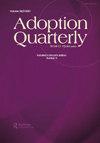Caregiver-Child Interaction in Children Placed into Different Types of Russian Families following an Institutional Intervention
IF 0.6
Q3 SOCIAL WORK
引用次数: 0
Abstract
Abstract The current study examined whether interventions in St. Petersburg, Russian Federation, institutions for infants (Baby Homes) that increased caregiver sensitivity (Training Only) or both caregiver sensitivity and consistency (Training plus Structural Changes: T + SC) versus care as usual (No Intervention: NoI), and the type of post-institutional (PI) families (Relatives versus Non-Relatives) in relation to the length of institutionalization would be associated with caregiver-child interaction advantages in the families. The Parent-Child Early Relational Assessment (Clark, 1985) method was used to assess the caregiver-child interactions at the stages of ≤24 months (n = 55), and 25-48 months of family placement (n = 48). Results suggest that at the stage of 24 months several interactional characteristics were better in families with children from T + SC than from NoI, especially the longer time children spent in these BH, and in families of Non-Relatives than Relatives. At 25-48 months, children in Non-Relative families displayed more Activity and Quality of Exploratory Play than in Relative families. Overall, these results suggest that at ≤24 months in PI families, advantages in caregiver-child interaction might be associated with better institutional caregiving and the type of families, whereas at 25-48 months it might be related only to the type of families.机构干预后被安置在不同类型俄罗斯家庭的儿童的照顾者-儿童互动
摘要当前的研究调查了俄罗斯联邦圣彼得堡的婴儿机构(婴儿之家)的干预措施是否提高了照顾者的敏感性(仅限培训)或照顾者的敏感度和一致性(培训加结构变化:T + SC)与照例护理(无干预:无干预),以及机构后(PI)家庭的类型(亲属与非亲属)与机构时间的关系将与家庭中的照顾者-儿童互动优势有关。亲子早期关系评估(Clark,1985)方法用于评估≤24岁阶段的照顾者与儿童的互动 月(n = 55)和25-48 家庭安置月数(n = 48)。结果表明,在24岁时 几个月来,有来自T + SC比来自NoI,尤其是孩子们在这些BH和非亲属家庭中度过的时间比亲属更长。25-48 月,非亲属家庭的儿童比亲属家庭的孩子表现出更多的探索性游戏活动和质量。总体而言,这些结果表明,在≤24 在PI家庭中,照顾者与孩子互动的优势可能与更好的机构照顾和家庭类型有关,而在25-48岁时 几个月来,它可能只与家庭类型有关。
本文章由计算机程序翻译,如有差异,请以英文原文为准。
求助全文
约1分钟内获得全文
求助全文
来源期刊

Adoption Quarterly
SOCIAL WORK-
CiteScore
1.60
自引率
12.50%
发文量
3
期刊介绍:
Adoption Quarterly is an unparalleled forum for examining the issues of child care, of adoption as viewed from a lifespan perspective, and of the psychological and social meanings of the word "family." This international, multidisciplinary journal features conceptual and empirical work, commentaries, and book reviews from the fields of the social sciences, humanities, biological sciences, law, and social policy. In addition to examining ethical, biological, financial, social and psychological adoption issues, Adoption Quarterly addresses continuity in adoption issues that are important to both practitioners and researchers, such as: negotiation of birth and adoptive family contact.
 求助内容:
求助内容: 应助结果提醒方式:
应助结果提醒方式:


